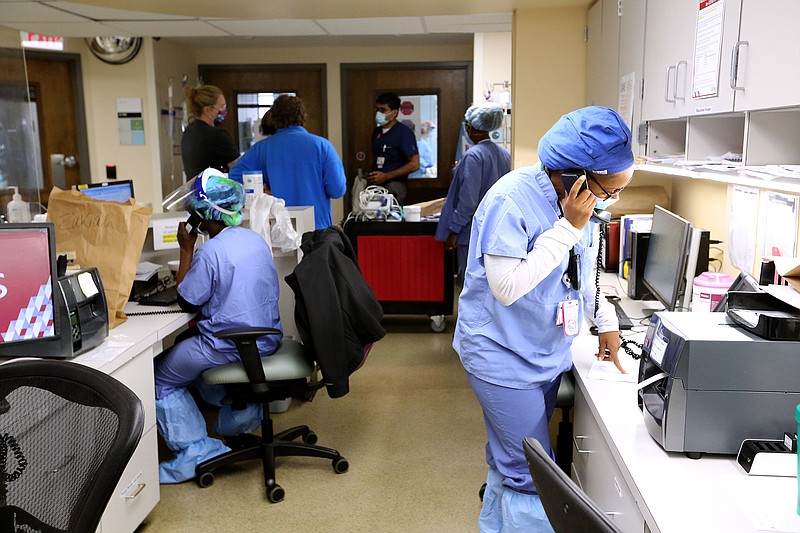In a further indication of the accelerating spread of the coronavirus in Arkansas, the state's count of cases rose Wednesday by 1,332, the second daily increase in a row that topped 1,000 and the third-largest one-day spike since February.
Growing for the fourth day in a row, the number of covid-19 patients reported to be in the state's hospitals rose by 30, to 241, its highest level since March 13.
The state's death toll from the virus, as tracked by the Department of Health, rose by six, to 11,580.
The jump in the number reported to be hospitalized was the largest in a single day since Jan. 26, during the state's first wave of infections from the omicron variant.
Explaining the abrupt rise, State Epidemiologist Mike Cima said Wednesday, "A particular hospital system reporter did not update their numbers from Thursday to today.
"During that period of time they were having a steady increase, but it wasn't reflected until today."
Since Saturday, the number hospitalized has risen by 56, a shift from the previous several days when it hovered at just less than 200.
"We kind of expected that hospitalizations would change because it's just obvious at this point that there is a lot of disease in the community," Cima said. "There's a lot of spread happening."
Still, he said hospitalizations and deaths have remained low compared with previous waves of infection. That's likely, in part, because of the large number of people with some immunity resulting from previous infections, vaccination or both, he said.
He said treatments such as Pfizer's Paxlovid pill also have helped.
"At prior points when we were at 1,300, 1,400, 1,500 cases, our hospitalizations were not where they are now," Cima said.
"They were quite a bit higher."
He said only one of the deaths reported Wednesday happened within the past month. Of the others, one occurred in February, three were from April and one was from May.
"Compared to where we have been, deaths are remarkably low," Cima said.
"We'd love to see the number be zero, but they are the lowest that they've been, frankly, that I can remember."
Pulaski County had the most new cases, 199, on Wednesday, followed by Washington County with 121 and Benton County with 71.
The state's cumulative count of cases since March 2020 rose to 864,155.
Already at its highest level since Feb. 20, the number of cases in the state that were considered active grew by 481, to 10,664, as new cases outpaced recoveries.
After falling by three a day earlier, the number of the state's virus patients who were on ventilators rose Wednesday by two, to 12.
Growing for the third day in a row, the number who were in intensive care rose by eight, to 48, the largest number since March 23.
At its hospitals in Little Rock and Springdale, Arkansas Children's had 12 covid-19 patients Wednesday, the same number as a day earlier and up from seven a week earlier, spokeswoman Hilary DeMillo said.
ACCELERATING SPREAD
The largest daily increase in cases since February so far was the spike of 1,434 cases June 23, followed by the 1,420 cases that were added Tuesday.
While smaller than those increases, the one Wednesday was larger by more than 500 than the one the previous Wednesday.
The average daily increase in the state's case count over a rolling seven-day period rose Wednesday to 1,005, the first time it had been more than 1,000 since Feb. 21.
"I'm still stopping short of classifying this as an explosion or exponential increase" similar to what the state experienced during previous surges, Cima said.
"I certainly think the slope is increasing. It has certainly been the case in the past two days here when, compared to the week prior, we're almost doubling the number of cases that we reported out."
He said the escalation is likely because of the omicron subvariants known as BA.4 and BA.5.
Combined, the two strains accounted for more than half the new cases in the United States last week, according to U.S. Centers for Disease Control and Prevention estimates.
BA.4 and BA.5, Cima said, are "without question," more transmissible than BA.2.12.1, which initially fueled the upward trend in Arkansas' new cases that began in late April.
He said the emergence of the more transmissible strains may explain a stall in the decline in new cases in some northeastern states that experienced upticks before Arkansas.
Although new infections have yet to explode in the same way they did during the initial omicron wave this past winter, Cima cautioned that the picture could change as people's immunity from previous infections and vaccinations continues to wane.
"What this looks like going into to the fall is not certain," Cima said. "It really remains to be seen what we're in for."
